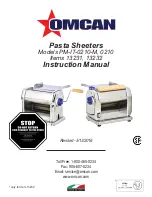
Since the bread program on your Automatic
is
completely computerised, the success of your loaf depends on the quantity
and quality of the ingredients
Flour:
Wheat flour provides the bulk and
structure of bread. Flour is classified
into two types, strong flours which are
milled from hard wheat and weak
flours which are milled from soft
wheat. The difference in the two types
of wheat is the content of proteins that form gluten
(ÒglutenÓ is the important constituent of bread which
provides its structure and its stretchy, chewy texture.
Gas which is released during fermentation is trapped
within the elastic network of gluten, thus making the
dough rise. Gluten development mostly takes place
during dough kneading).
Strong flours
contain a high content of proteins
necessary for the development of gluten. ÒBread flourÓ
and ÒBakers flourÓ are the major product within this
category. Most of the recipes in this book call for this
flour.
Weak flours
such as cake flour and pastry flour, are
less in protein content and are suitable for products
which have a light, crumbly texture and do not require
much gluten development.
Self raising flour
is a white flour to which baking
powder and sometimes salt has been added. Weak
flours and self raising flour
alone may not
be
substituted for bread flour in the included recipes.
Unbleached plain flour
is white wheat flour which has
not been bleached to whiten it. Most plain flours have
a gluten content of approximately 4-5%. For successful
results when baking bread, 8-9% is required. Plain
flour may be used if supplemented with gluten flour or
bread improver.
Continental flour
is a flour similar to bakers or bread
flour but is ground very fine. This produces a very
smooth even loaf.
Gluten (Gluten Flour or Wheat Gluten)
is a flour
extremely high in gluten content. Use approximately
1
/
4
cup (35
N
) to flours with a low gluten content to
improve suitability for use.
Rye flour contains some proteins but these do not
form sufficient gluten. Therefore, bread baked with
rye flour will be dense and heavy.
Ingredients
¨
Whole wheat flour or wholemeal wheat flour
is
made by grinding the entire wheat kernel, including the
bran and germ. 100% whole wheat bread or breads
containing a high percentage of whole wheat flour will
be lower in height and heavier in texture than bread
baked with flour. If you are not pleased with the height
and the texture of the whole wheat bread, you could
strengthen the bread by increasing the proportion of
white bread flour. (You must reduce the same
proportion of whole wheat flour so that the total amount
of wheat flour would remain the same.) The life of whloe
wheat flour and its baked products is shorter than
white bread flour and its baked products, because the
included germ is high in fat, which can become rancid.
Other flour: Products milled from other grains are
occasionally used in bread. i.e. corn meal, rice, millet,
soy, oat, buckwheat and barley flours. These do not
contain protein that form sufficient gluten and
therefore they should not be substituted for bread
flour in the following recipes.
Sugars:
Sugars or sweetening agents
have the following purposes in
bread making:
¥ They add sweetness and flavour.
¥ They add softness and fineness to
the texture.
¥ They give crust colour.
¥ They contribute to keeping
qualities by retaining moisture.
¥ They provide food for yeast.
Besides granulated sugar or caster sugar, brown
sugar, honey and molasses can be substituted in the
recipes. Recipes including fruit generally require less
added sugar due to the high sugar content of the fruit.
Fats:
The major purpose of fats in bread
baking are:
¥ They tenderize the bread.
¥ They add flavour and richness.
¥ They contribute to keeping qualities
by retaining moisture.
Any fat can be used, however, we
recommend butter for the best flavour
and texture.
-
17
-
Summary of Contents for SD-206
Page 1: ...SD 206...
















































